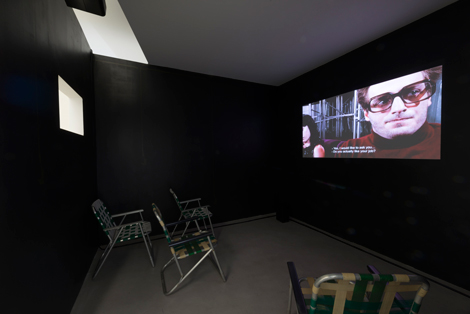German filmmakers Christine Lang and Constanze Ruhm have thrown movie-making ingredients intelligently into a blender. After 15 minutes of imbibing this concoction, questions as to whether your taste agrees with it, and a curiosity about what specific elements are in it, keep you sucking at the straw.
In a Lynch-like construction of scenes, viewers are taken to a scenery of deceased actors and a storyline attached to Hal Lucas, a director (possibly a reflection of Godard), who is now a janitor and contemplating how he has fallen from the successful plinth he once stood upon. He appears throughout the film, meeting the corpses of film history.
Hal wanders through the stage set of a talk show that has stairways at either end. There he finds the remnants of objects, characters, lovers and eventually sees his own body and death. Scenes from Blue Velvet (1986), Vertigo (1958) and Eraserhead (1977) are subtly remade by the film’s close-up and angled perspective shots. These copycat frames only add to making the film beautiful, odd and familiar.
The women Hal meets on his journey bring up romantic relationships thrown away. They are used objects from the male domination of filmmaking. The actresses give monologues on their roles, which comment on actress objectification and add a feminist slant to the film. We see casts of Gainsbourg, Godard and Henry Miller saunter aimlessly into the discussion and onto the sets. Deceased actresses argue back and forth about being defined as the subject or object—each fighting for a title, but which title remains undetermined.
A scene of a lawn chair-filled room, where the deceased actresses discuss their roles, starts and ends the film. It is no coincidence that architecture firm First Office (Andrew Atwood and Anna Neimark) set their own seating of lawn chairs in the screening room built within the 2nd floor of the MAK garage. This places viewers subliminally in the bookended scenes to make them part of the conversation.
It is in these moments of the film that viewers are pulled into the contextual sceneries of space, where there is a landscape of objects. At one point Hal finds himself mysteriously in a forest, connected to a natural environment, foreign and unfamiliar to him. But it is almost too familiar—long bare trees that could be German woods or forests by Walden Pond. It is where Hal quotes Henry Miller: “In my next life, I’d like to return as a park.” He stumbles through the branches and comes upon an abandoned white concrete building, perhaps a bunker, with “Reservazion” scripted on the side. The director is not a park, but is left, like the structure, in the relics of past film scenes, with characters and objects used by others. Lang and Ruhm beckon us to question how they—and we—make reference to these cultish figures, images and objects that make up the films over which we obsess.



